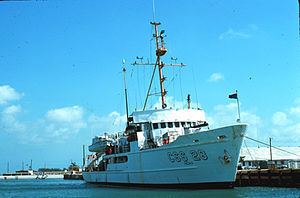Name USC&GS Peirce (CSS 28) Acquired May 1963 (delivery) Length 50 m | Launched October 1962 Commissioned 6 May 1963 Weight 921.6 tons | |
 | ||
Namesake Charles Saunders Peirce (1839-1914), U.S. Coast Survey and U.S. Coast and Geodetic Survey employee (1859-1891), an intellectual, physical scientist, and philosopher Builder Marietta Manufacturing Company, Point Pleasant, West Virginia | ||
NOAAS Peirce (S 328), was an American survey ship that was in commission in the National Oceanic and Atmospheric Administration (NOAA) from 1970 to 1992. Previously, she had been in commission in the United States Coast and Geodetic Survey from 1963 to 1970 as USC&GS Peirce (CSS 28).
Contents
After her NOAA decommissioning, she was donated to the Intrepid Sea, Air & Space Museum for use as the floating classroom and archaeological research ship MV Elizabeth M. Foster. She was sold for private use in 1999 and in 2001 became the yacht MV Avedonia.
Construction and commissioning
Peirce was built a cost of $2,300,000 (USD) as a "coastal survey ship" (CSS) for the U.S. Coast and Geodetic Survey by the Marietta Manufacturing Company at Point Pleasant, West Virginia. She was launched in October 1962 and delivered in May 1963. The Coast and Geodetic Survey commissioned her on 6 May 1963 at the Alabama State Docks in Mobile, Alabama, as USC&GS Peirce (CSS 28), the first and only Coast and Geodetic Survey ship of the name. When the Coast and Geodetic Survey and other United States Government agencies merged to form NOAA on 3 October 1970, Peirce became a part of the NOAA fleet as NOAAS Peirce (S 328), thus far the only NOAA ship to bear the name.
Capabilities
Peirce had a two-drum oceanographic winch with a maximum pull of 1,500 pounds (680 kg). The upper drum had 10,000 feet (3,048 meters) of 0.3-inch (7.62-mm) electric cable, while the lower drum had 15,000 feet (4,572 meters) of 5/16-inch (7.9-mm) cable. She had a 27-foot (8.2-meter) telescoping boom with a lifting capacity of 2,500 pounds (1,134 kg) and a 27-foot (8.2-meter) articulating boom with a lifting capacity of 2,768 pounds (1,256 kg), as well as a movable A-frame.
For acoustic hydrography and bathymetry, the ship had a deep-water echosounder, a shallow-water echosounder-lOOKhz, and a hydrographic survey sounder. To process data, she had the National Ocean Service's Hydrochart system, which employed a PDP/8E computer to acquire and process hydrographic data in real time, generate a real-time position-corrected plot of sounding data, provide steering commands to the helmsman, and generate a punched paper tape for shore-based processing of sounding dara.
Peirce had an ice-strengthened steel hull.
Peirce carried two 29-foot (8.8-meter) aluminum-hulled diesel-powered Jensen survey launches, each equipped with the same Hydrochart system as aboard Peirce. For utility and rescue purposes, she also carried two open boats with gasoline-powered outboard motors, a 16-foot (4.9-meter) Boston Whaler fiberglass-hulled boat and 17-foot (5.2-meter) Monark aluminum-hulled boat.
Operational career
From her home port at Norfolk, Virginia, Peirce conducted hydrographic and bathymetric surveys involving nautical charting and ocean mapping, primarily along the United States East Coast and United States Gulf Coast and off territories of the United States in the Caribbean.
NOAA decommissioned Peirce on 1 May 1992.
Floating classroom and yacht
In 1992, Peirce was donated to the Intrepid Sea, Air & Space Museum in New York City. The museum acquired her for use as a floating classroom and archaeological research ship and renamed her MV Elizabth M. Foster in 1993. In 1999 the museum sold her for private use, and in 2000 she returned to the name MV Peirce. By 2001 she was operating as the private yacht MV Avedonia.
